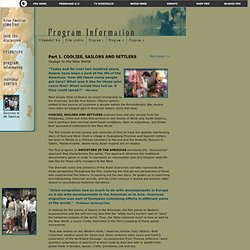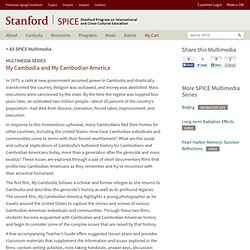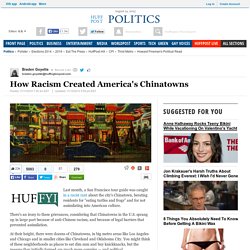

Ancestors in the Americas" "Asian emigration had as much to do with developments in Europe as it did with developments in the Americas or in Asia.

American Orientalism. One day in early October 2001, three weeks after the Al Qaeda attacks on the World Trade Center and Pentagon, Ansar Mahmood was out delivering pizzas in the town where he lived and worked in the Hudson River Valley, north of New York City.

Mahmood was a green-card-holding immigrant from Pakistan. He had recently written to his sister back home about how beautiful the valley was, and he wanted to send her a picture. That day, as the sun began to set, he pulled over at a scenic spot and asked two men who were nearby to take a picture of him against the backdrop of the serene river and colorful fall foliage. In an interview with author and activist Irum Shiekh, Mahmood remembered receiving a call from his boss soon afterward; police were at the pizzeria and wanted to speak to him. Unknown to Mahmood, the area where he had earlier taken a photo was close to a water treatment plant. The contrast was stark. But this was not merely a post–9/11 phenomenon. The First Vietnam: The U.S.-Philippine War of 1899. By Luzviminda Francisco (1973) *With apologies to Mexicans, American Indians and other early victims of American imperialism.

Introduction One of the most startling phenomena of recent Philippine history has been the development of a popuiar movement calling for the relinquishing of Philippine sovereignty and for political re-union with the U.S. as the 51st state. Although the "statehood movement" was understandably treated as something of a joke when it first surfaced several years ago, its popular reception and rapid growth, especially in the face of surging Philippine nationalist and anti-imperialist sentiments, demands that the movement and the ideology which it represents be carefully analyzed.
Philippine-American War, 1899-1902. SPICE - My Cambodia and My Cambodian America. In 1975, a radical new government assumed power in Cambodia and drastically transformed the country.

Religion was outlawed, and money was abolished. Mass executions were sanctioned by the state. By the time the regime was toppled four years later, an estimated two million people—about 25 percent of the country’s population—had died from disease, starvation, forced labor, imprisonment, and execution. In response to this tremendous upheaval, many Cambodians fled their homes for other countries, including the United States. How have Cambodian individuals and communities come to terms with their forced resettlement? The Search For General Tso. Mr Beller's Neighborhood. They Steal Young Girls by Carol J.

Binkowski 03/23/2009Neighborhood: Chinatown “You can’t walk around here! They steal young girls and sell them as slaves.” Grandma’s voice hit a higher pitch with each syllable, her blue eyes sparking with agitation behind the dark rims of her glasses. The Chinatown of the American South - Pacific Standard. When one thinks of American Chinatowns, they usually think of San Francisco and New York, but at one time the third largest Chinatown in the United States was in Louisiana.

It’s story is an example of how economics and geopolitics shape the growth of ethnic enclaves. After the American Civil War ended legalized slavery in the U.S., Southern planters faced the challenge of finding labor to work their crops. It was common to employ the same black men and women who had been enslaved, now as sharecroppers or wage laborers, but the planters were interested in other sources of labor as well. At nola.com, Richard Campanella describes how some planters in Louisiana turned to Chinese laborers.
Ultimately, they hired about 1,600 Chinese people, recruited directly from China and also from California. This would be a doomed experiment. How Racism Created America's Chinatowns. Last month, a San Francisco tour guide was caught in a racist rant about the city's Chinatown, berating residents for "eating turtles and frogs" and for not assimilating into American culture.

There's an irony to these grievances, considering that Chinatowns in the U.S. sprang up in large part because of anti-Chinese racism, and because of legal barriers that prevented assimilation. At their height, there were dozens of Chinatowns, in big metro areas like Los Angeles and Chicago and in smaller cities like Cleveland and Oklahoma City. You might think of these neighborhoods as places to eat dim sum and buy knickknacks, but the reasons they initially formed are much more complex -- and political. How Has Chinatown Stayed Chinatown? Every summer, Wellington Chen, the director of Chinatown’s Business Improvement District, dispatches interns to document all the businesses that have recently opened and closed in his neighborhood.

He has noticed an overwhelming number of empty storefronts being filled by independent pharmacies. At the same time, senior and adult day-care centers have been proliferating — starting with a 19,000-square-foot building the city has installed on Centre Street. Chen says it’s a subtle indication of a trend: As so many immigrants’ children have left for college and never returned, and as other families have sought real estate in the outer boroughs (particularly in Sunset Park, Brooklyn, and Flushing, Queens), most of the people left in Chinatown’s historic core are the elderly dwellers of rent-regulated apartments. How can this possibly be the state of one of the most desirable tracts of real estate in all of Manhattan? 1. 2. You May Not Know About The First Chinese Americans, But You Should. It wasn't easy being Chinese American in the early days.

From exclusionary laws to the racist caricatures that dotted newspaper comic pages, America wasn't exactly laying down the welcome mat. And yet, there were success stories. The Chinese American, a newspaper founded by the activist and journalist Wong Chin Foo, hit stands before the end of the 19th century. The actress Anna May Wong, born in Los Angeles to Chinese parents, beat the odds and wound up starring in silent films a few decades later.
Some died too young to become known, like the World War II fighter pilot below. Mary Tape was an orphan from Shanghai. She arrived... - California State Library. The Agonizing Odyssey of Two People Kept Apart by Immigration Laws. These Nightclub Entertainers Paved The Way For Asian-Americans In Showbiz : Code Switch. A mid-1940s postcard from San Francisco's Forbidden City nightclub, which opened in 1938.

Courtesy DeepFocus Productions Inc. Hide caption itoggle caption Courtesy DeepFocus Productions Inc. A mid-1940s postcard from San Francisco's Forbidden City nightclub, which opened in 1938. Courtesy DeepFocus Productions Inc. As a kid growing up in San Francisco, filmmaker Arthur Dong often walked by a nightclub just outside of Chinatown. Of Another Fashion. Maxine Hong Kingston, The Warrior Woman. In 1976, following the eve on which Maxine Hong Kingston was recognized by the National Books Critics Circle for her memoir, The Warrior Woman, the author discussed her work with Charles Ruas. The award winning book was the subject of much of their conversation, finding relevance in not just the Chinese American experience, but notable for its perspective on gender and global politics.
Hong Kingston explains how the book's title is a reference to Chinese mythology, channeling the idea that in martial arts, the woman's body alone can be perfected. She reveals her interest in examining this and similar paradoxes, as well as exploring madness within her work. She likens the paradoxical tendencies of madness to practices exercised by writers. In some cases, these instances are more explicit. Novelist Maxine Hong Kingston (b. 1940) is known for her texts on the Chinese American experience and contributions to the feminist movement. Taiko Drumming in North America. Gordon Hirabayashi, 1918-2012. By Guest Contributor Phil Yu, cross-posted from Angry Asian Man Received word through social media that civil rights hero Gordon Hirabayashi, best known for being one of the few people to openly defy the government’s unconstitutional internment of Japanese Americans during World War II, has died.
He was 93. Exploring the “hidden legacy” of World War II internment camps. Exploring the “hidden legacy” of World War II internment camps Posted by Angela Erika Kubo on Wednesday, April 16, 2014 · Leave a Comment Most documents and research on the internment camps for Japanese-Americans during World War II focus on the political situation of that time, the harsh conditions within the camps, and the forced “Americanization” of the inmates.
Forgotten documents reveal views on return of Japanese internees to Monterey Peninsula. In late August, local historian Tim Thomas was searching through a bank of file drawers in the second-floor conference room of the Japanese American Citizens League Hall in Monterey when he made a startling discovery. In a slightly frayed, rolled-up, legal-sized envelope dated May 9, 1945, he found a cache of West Coast history related to the mass incarceration of 120,000 Japanese, including American citizens, during World War II. It had not been seen in nearly 70 years. Name: Patsy Matsu Takemoto Mink Dates: 1927-2002 ... - Because of This Woman. Korean Percussion Music & Dance in USA.
A review of Diasporic P’ungmul in the United States: A Journey between Korea and the United States, by Soojin Kim. Soojin Kim’s dissertation explores the genre of p’ungmul percussion music and dance as it has been transmitted from South Korea to the United States in the late twentieth century. Based on extensive multi-sited research in Los Angeles and New York, this ethnomusicological study is a story of both continuity and change. Simon C. Kim, "Memory and Honor" (Liturgical Press, 2013) (Yonhap Feature) For adoptees, DNA is game changer for finding roots. South Asian American Digital Archive (SAADA) Masum Momaya, Before and After "Beyond Bollywood"
Working from the premise that an exhibition is not "finished" when it opens its doors to the public and that audiences can also be cited as collaborators, Smithsonian Curator and Curatorial Intensive Alumna Masum Momaya reflects on her curatorial practice, using the exhibit Beyond Bollywood: Indian Americans Shape the Nation as a jumping off point. What Is the Line Between Cultural Respect and (Mis)appropriation? Indian American Model on Racism in the Fashion Industry: Daily Beauty Reporter: allure.com. The Kitchen Sisters. Five Historical Movies About Asians Hollywood Never Made at Asian American Film Lab.
Asian American Film. The Chinese 'Paper Son' Who Inspired The Look Of Disney's 'Bambi' The Walt Disney Studio's artists used Tyrus Wong's paintings as a guide for the forest backgrounds of Bambi. His work is featured in a new exhibit at the Museum of Chinese in America. On Mississippi Masala and Being Seen - The Toast. Manisha Aggarwal-Schifellite’s previous work for The Toast can be found here. I don’t remember when I first learned about the idea of “model minorities,” but when I was younger, it seemed like a good thing that people would assume I was smart, high achieving, and loyal to my family. My first thought was always “Look, there we are!” When I saw brown people on TV, even if it was another nerdy engineer, a store clerk, or another tiny genius winning the National Spelling Bee.
"We're here, and we can play all sorts of roles": Julia Cho on Acting and APIA Representation. A Brief, Weird History Of Squashed Asian-American TV Shows : Code Switch. “Asian Americans in Fashion” on CUNY TV. Behind the Shield. Vishavjit Singh is an engineer, writer, educator, activist, costume player and the artist behind Sikhtoons.com.
A crusader for cross-cultural understanding, this real-life superhero spoke with Teaching Tolerance about using his powers to dispel myths about Sikhs and to encourage a new generation of comic book artists to share their stories. How did you come to cartooning? For me cartooning really came out of a tragedy: 9/11. Pacific Standard. RE: Angry White Girl. Fetishizing Asian Men, Stereotyping Asian Women… that Shit is Racist. The Poet Bao Phi, On Creating A 'Guidebook' For Young Asian-Americans : Code Switch. A Conversation About Asian-American Erotic Fiction. Looking Behind the Myths of Asian American Parenting. Thuy Linh Tu, “The Beautiful Generation: Asian Americans and the Cultural Economy of Fashion” (Duke UP, 2010) Nicholas Hartlep, “The Model Minority Stereotype: Demystifying Asian American Success” (Information Age, 2013)
Madeline Y. Hsu, "The Good Immigrants: How the Yellow Peril Became the Model Minority" (Princeton UP, 2015) Five ways the myth of the “model minority” hurts all of us. What Happens to All the Asian-American Overachievers When the Test-Taking Ends? “Model Minority” Pressures Take Mental Health Toll. Tragedy of ‘golden’ daughter’s fall resonates with Asian immigrant children. The Dangerous Weight of Expectations - Pacific Standard.
Diagnosing the Asian American Eating Disorder - Mochi Magazine. This Is What It's Like To Recover From An Eating Disorder During Ramadan. Is Beauty In The Eye(Lid) Of The Beholder? : Code Switch. Eight Ways I’ve Been Made to Feel About My Asian Eyes. No Fats, No Femmes, No Asians: Adventures in Gay Identity. The (Geo)Politics of Korean Cosmetic Surgery. What Goes Through Your Mind: On Nice Parties and Casual Racism. "You left your culture at the door" - The Toast. Why Yellow Fever Is Different than “Having a Type” » #27 The Fever. Who the drugs kill.